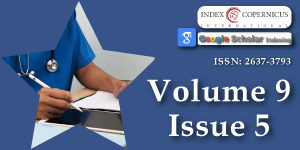Synergistic Heterozygosity in Rare Digenic Hereditary Anemias Accurately Diagnosed by whole Exome Sequencing
Main Article Content
Article Details
Copyright (c) 2025 Angel-Rodríguez F, et al.

This work is licensed under a Creative Commons Attribution 4.0 International License.
1. Piel FB, Steinberg MH, Rees DC. Sickle Cell Disease. New England Journal of Medicine. 2017 Apr 20;376(16):1561–73.
2. Onimoe G, Rotz S. Sickle cell disease: A primary care update. CCJM. 2020 Jan 1;87(1):19–27.
3. Fong C, Lizarralde-Iragorri MA, Rojas-Gallardo D, Barreto G. Frequency and origin of haplotypes associated with the beta-globin gene cluster in individuals with trait and sickle cell anemia in the Atlantic and Pacific coastal regions of Colombia. Genet Mol Biol. 2013 Dec;36(4):494–7.
4. Kato GJ, Piel FB, Reid CD, Gaston MH, Ohene-Frempong K, Krishnamurti L, et al. Sickle cell disease. Nat Rev Dis Primers. 2018 Mar 15;4(1):1–22.
5. Pinto VM, De Franceschi L, Gianesin B, Gigante A, Graziadei G, Lombardini L, et al. Management of the Sickle Cell Trait: An Opinion by Expert Panel Members. J Clin Med. 2023 May 12;12(10):3441.
6. Zanella A, Bianchi P, Fermo E. Pyruvate kinase deficiency. Haematologica. 2007 Jun 1;92(6):721–3.
7. Manco L, Vagace JM, Relvas L, Rebelo U, Bento C, Villegas A, et al. Chronic haemolytic anaemia because of pyruvate kinase (PK) deficiency in a child heterozygous for haemoglobin S and no clinical features of sickle cell disease. Eur J Haematol. 2010 Jan 1;84(1):89–90.
8. Alli N, Coetzee M, Louw V, van Rensburg B, Rossouw G, Thompson L, et al. Sickle cell disease in a carrier with pyruvate kinase deficiency. Hematology. 2008 Dec;13(6):369–72.
9. Cohen-Solal M, Préhu C, Wajcman H, Poyart C, Bardakdjian-Michau J, Kister J, et al. A new sickle cell disease phenotype associating Hb S trait, severe pyruvate kinase deficiency (PK Conakry), and an alpha2 globin gene variant (Hb Conakry). Br J Haematol. 1998 Dec;103(4):950–6.
10. Risinger M, Christakopoulos GE, Schultz CL, McGann PT, Zhang W, Kalfa TA. Hereditary elliptocytosis-associated alpha-spectrin mutation p.L155dup as a modifier of sickle cell disease severity. Pediatr Blood Cancer. 2019 Feb;66(2):e27531.
11. Ustun C, Kutlar F, Holley L, Seigler M, Burgess R, Kutlar A. Interaction of sickle cell trait with hereditary spherocytosis: splenic infarcts and sequestration. Acta Haematol. 2003;109(1):46–9.
12. Vockley J, Rinaldo P, Bennett MJ, Matern D, Vladutiu GD. Synergistic heterozygosity: disease resulting from multiple partial defects in one or more metabolic pathways. Mol Genet Metab. 2000;71(1–2):10–8.
13. Naik RP, Haywood C. Sickle cell trait diagnosis: clinical and social implications. Hematology Am Soc Hematol Educ Program. 2015;2015(1):160–7.
14. Tubman VN, Field JJ. Sickle solubility test to screen for sickle cell trait: what’s the harm? Hematology Am Soc Hematol Educ Program. 2015;2015:433–5.
15. Benson JM, Therrell BL. History and current status of newborn screening for hemoglobinopathies. Semin Perinatol. 2010 Apr;34(2):134–44.





